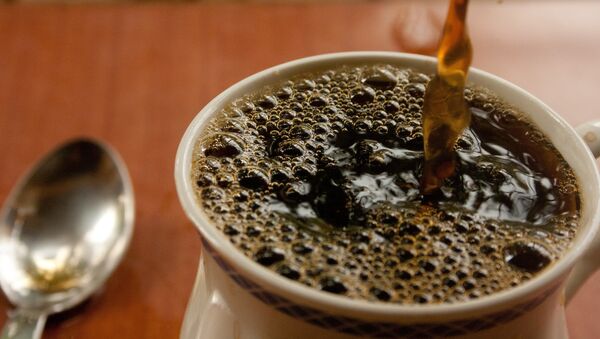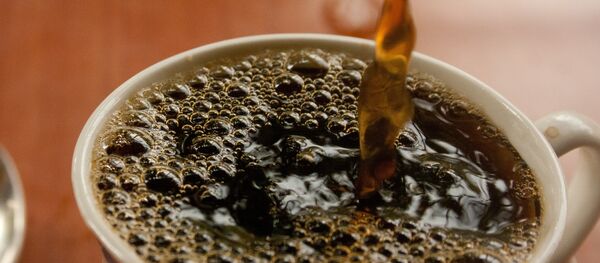New Delhi (Sputnik) — It would not be an exaggeration to say that India is a nation of tea drinkers, considering that the domestic market consumes about 70 percent of the tea that is produced in the country. India is the second-largest producer of tea in the world, behind China. Furthermore, the Indian tea industry is making a push to expand tea exports to China beyond the current figure of nearly 30 percent of tea imported by China.
Meanwhile, in India, tea is a part of the daily routine. People drink tea at regular intervals for refreshment and it's often accompanied with a hearty dose of snacks and conversations. Tea is offered to guests as a preferred welcome drink. At homes, kitchens rarely run out of tea leaves. At work, people hang around tea vending machines to take a break.
Everywhere you go, you can easily find places that serve tea, from roadside tea stalls to iconic Irani cafes, tea joints serve as rendezvous points. Tea culture in India is so pervasive that the current ruling party had employed a pre-poll campaign titled 'Chai pe Charcha,' meaning 'discussions over tea,' in order to reach out to the electorate.
— Megha Mohan (@meghamohan) September 9, 2018
Assam Tea
The north-eastern state of Assam is one of the largest tea growing regions in the world and is renowned for its black tea. The tropical climate and heavy rainfall in Assam are conducive to lush tea plantations. Assam tea is strong, full-bodied and malty, and is a popular choice for breakfast tea. Tea is generally harvested twice annually. The first flush is picked in March. The later flush is the prized harvest of the golden-tipped tea leaves.
— NorthEast United FC (@NEUtdFC) October 27, 2018
Darjeeling Tea
Darjeeling town, in the Himalayan foothills, produces an exotic and delicate tea variety that is exclusive to the region. The Tea Board of India ensures that only those batches of tea that have been entirely cultivated and processed in Darjeeling carry the label Darjeeling tea. It's marketed as the Champagne of teas, and aptly so, considering that the tea output is as nuanced as the grapes grown in the Champagne region of France. The first flush that is harvested after spring showers has a very delicate color and aroma and is mildly astringent. The subsequent flushes grow in the intensity of their color and body. In general, Darjeeling tea is spicier but much lighter than Assam tea and is best prepared without milk. Assam tea, on the other hand, works well with or without milk.
— CIPAM (@CIPAM_India) October 23, 2018
The quintessentially Indian 'masala chai' is a potent tea-based beverage that is brewed with sugar, milk and any number of herbs and spices and is boiled multiple times over to make it strong, aromatic, and flavorful. The choice of infusions can provide different characteristics to this tea preparation. Spices such as cardamom and cinnamon create pleasant and aromatic flavors. The addition of medicinal herbs turns an average cup of tea into a home remedy for maladies such as cold, cough and stomach upsets. The sugary and milky tea makes the bitter additives more palatable. Immunity boosting and soothing ingredients such as ginger and basil are commonly used. Many people are in the habit of drinking three to four cups of masala tea every day. In Maharashtra, there is a way to cut back on chai masala cravings: locals often order a 'cutting chai', which essentially means half a cup of tea.
masala tea or masala chai is one of the favorite drinks among Indians especially during the monsoon and cold winters. It is believed that it keeps the body warm and break up the blocked sinus. A large population drink it around the year along with their breakfast. pic.twitter.com/7nXyA0KCrC
— kashmir business view (@kbusinesview) October 27, 2018
Irani Chai
When Iranian Zoroastrian immigrants settled in India, they brought with them Iranian cuisine, especially their distinctive tea recipe known as Irani Chai. Iranian style cafes are popular in the bustling streets of the old city in Hyderabad and also parts of Mumbai and Pune. It's said that a proper Irani chai can only be had at one of these cafes and no true-blue Iranian cafe-owner would ever disclose all the ingredients of its preparation. Yet, broadly speaking, the recipe involves mawa, a dairy product that is made by heating whole milk and reducing it to about one-fifth volume. Tea is brewed continually from morning to evening over a slow flame. Milk is condensed and sweetened in a separate vessel. At the time of serving, a cup is filled with tea and a little mawa is added to it.
Okay. Thats it. Hyderabad Irani chai is the greatest Chai ever. pic.twitter.com/Ikv7Egqujj
— Naveen (@ImNsamy) October 20, 2018
Tibetan Butter Tea
The trans-Himalayan regions of Ladakh, Zanskar, and Suru are known for their salty tea made with yak milk butter. Tea is boiled in water for several hours, sometimes up to half-a-day, and is stored to be used later. At the time of serving, this brew is put into special tea churns along with yak milk butter and salt, and is manually mixed vigorously for a few minutes. The tea is served in traditional shallow bowls and consumed several times per day. The high-fat content of the beverage is especially beneficial in the harsh and cold climate of these regions. The latest fad of adding butter and oil to coffee is not a new idea, and in several cultures, people have known the benefit of gulping down good fat for centuries.
Tibetan butter tea is traditionally made from tea leaves, yak butter, water, and salt. It is a regular part of Tibetan life. pic.twitter.com/OZ98azcRWm
— TeaVivre (@TeaVivre) July 26, 2017
In Kashmir, tea is served in traditionally crafted shallow cups. Kahwa is a traditional tea preparation in Kashmir. Green tea is brewed with saffron, cinnamon, cardamom and rose petals in a special kettle called a samovar, which first arrived in Kashmir from Russia via central Asia. It's then served with crushed nuts and sugar or honey. These infusions are not only good for digestion but also well-suited to the cold weather in the valley.
Noon Chai is the other variant of warm and soothing Kashmiri tea and is brewed with salt and nuts. It has a beautiful pink color due to the addition of a pinch of baking soda and milk.
— Sajid Yousuf (@AskYousuf) October 22, 2018
In India, whether the tea is had in formal cups, in clay or glass tumblers, or in disposable cups, it's equally relished at home and outdoors. Given the variety in tea production, preparation, and the associated cultural practices, it can be safely inferred that tea is the country's favored warm beverage.




